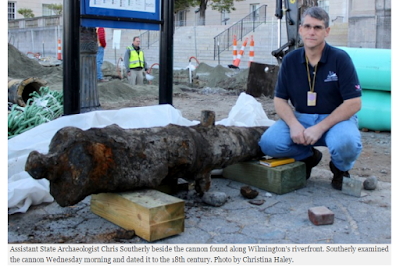Written by the TreasureGuide for the exclusive use of treasurebeachesreport.blogspot.com.
---
The PortCityDaily.com had this article about what appears to be an 18th century cannon that was found in Wilminton. It wasn't found in the water. It was found buried in front of the Federal Courthouse building there.
The article says, The cannon is cast iron, weighing about 700 to 800 pounds, Southerly said. While the cannon’s date is during a time when Wilmington was still a British colony – or maybe after it was incorporated as a city in 1739 – Southerly said the find is unusual because most of what’s been found in the immediate area usually dates to the Civil War period more than 100 years later.
“It’s been probably buried, maybe used as backfill or just an old cannon that was non-functional,” Southerly said. “More than likely it could have been off an armed vessel at the time. We have a lot of shipwrecks here in the vicinity, especially the Cape Fear River, that date from colonial times right on up to modern wrecks.”
Ships and things have been found in a lot of waterfront areas where they were buried. You probably read of the ship that was found buried at the site of the World Trade Center or some of the things buried at the bay area of San Francisco as the dock area was enlarged.
It might be worth remembering that the water line can change as a result of nature or the work of man. When the water line changes, old things can be exposed or buried.
The size of Florida has changed a lot over its history. We are told that Florida will be losing land as a result of melting ice and global warming.
What I talked about yesterday was changing water lines. I mentioned that there are long term trends and then there are the short term changes. Long term changes and the shorter term changes interact. A new cut in an area where sand has been accumulating for a longer period of time will not be very productive. On the other hand, a new cut in an area where sand has been eroding for a longer period of time, could well be productive.
One of the points that I think I failed to mention yesterday is that it helps to know the history of a beach and how the sand has come and gone in the past. It is helpful to know how far back a beach has eroded in the past and be able to compare that with the present beach. If you only have short term knowledge of a beach, you are at a disadvantage.
It is not difficult to identify a new cut, but it isn't always that easy to know when a beach has moved back towards the dunes are out into the water.
Here are some ways a beach can change shape.
Lets say the beach began as outlined by the brown line which begins at C and ends at C.
The dunes are on the left, which drop off, and then the beach slopes down to the water.
The beach could then accumulate sand, as shown by the purple line that goes from point B to point B.
In that case the beach keeps pretty much the same shape. Since the beach looks still looks very much the same, it can be difficult to see that so much sand has accumulated.
Similarly, the beach can look similar if sand is removed, but the beach keeps a similar shape as the sand is removed about the same amount from top to bottom.
If the beach moves out or back while keeping the same shape, unless you have a good visual memory or some landmarks to go by, it can be difficult to realize those changes.
A beach can also change slope, becoming steeper, as shown by the blue line ( D - D ), or becoming less steep, as shown by the red line ( A - A). In those cases, a small change of slope can be difficult to identify. A greater change in the slope will be easier to identify.
All of these different kinds of changes can be important. It should be part of the history of a beach that you should be able to recognize and record mentally or otherwise.
If the beach changes as shown by the red line, the beach can look like it is actually accumulating, and sand is accumulating on the beach front, but it is cutting away at the dunes. Things can be washed out of the dunes when that happens. You would therefore want to look along the base of the dunes.
If the beach changes as shown by the blue line, you would want to check along the water line,where the beach front has receded.
The illustration is far from perfect, but I think you get the idea. Beaches can change in a variety of ways. Some of the ways it can change might not be perfectly obvious, but it can be very helpful to recognize how a beach has changed.
Yesterday the wind was brisk and the surf was choppy. The waves were hitting from the east and where I was, there was no erosion to speak of.
The big Spring tides are gone. The predictions are for around a three foot surf and a south wind.
Happy hunting,
TreasureGuide@comcast.net

